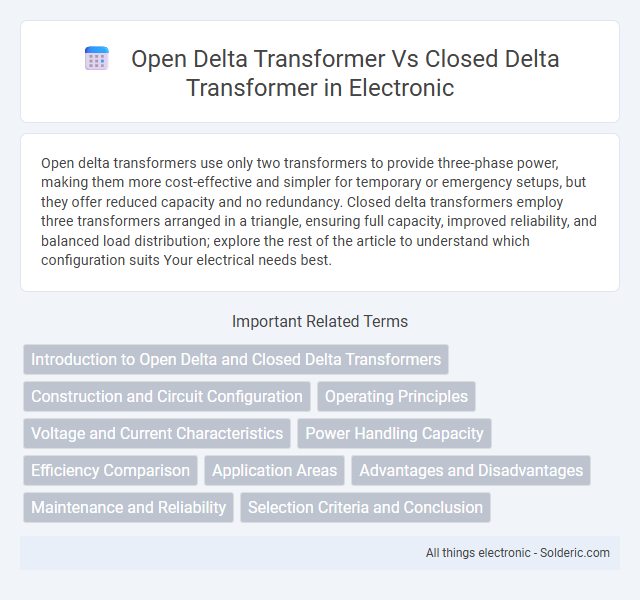Open delta transformers use only two transformers to provide three-phase power, making them more cost-effective and simpler for temporary or emergency setups, but they offer reduced capacity and no redundancy. Closed delta transformers employ three transformers arranged in a triangle, ensuring full capacity, improved reliability, and balanced load distribution; explore the rest of the article to understand which configuration suits Your electrical needs best.
Comparison Table
| Feature | Open Delta Transformer | Closed Delta Transformer |
|---|---|---|
| Configuration | Two transformers connected in delta; third winding omitted | Three transformers connected in a closed delta loop |
| Cost | Lower initial cost due to fewer transformers | Higher initial cost with three transformers |
| Capacity | Typically 57.7% of closed delta capacity | Full rated capacity with all three transformers |
| Reliability | Less reliable; if one transformer fails, system is compromised | More reliable; can continue operation with one transformer out |
| Applications | Used for emergency or temporary setups | Standard for permanent three-phase power distribution |
| Phase Shift | Provides necessary phase shift with less equipment | Provides balanced phase shift with all transformers |
| Maintenance | Lower maintenance due to fewer components | Higher maintenance needs with more components |
Introduction to Open Delta and Closed Delta Transformers
Open delta transformers use only two transformers to supply three-phase power, offering a cost-effective solution for lower loads and partial backup during transformer failure. Closed delta transformers utilize three transformers connected in a triangular configuration, providing balanced load distribution, higher reliability, and full three-phase power for critical industrial applications. The choice depends on load capacity, system reliability requirements, and budget constraints.
Construction and Circuit Configuration
Open delta transformers feature a three-wire configuration using only two transformers arranged in a V shape, allowing them to provide three-phase power with reduced equipment. Closed delta transformers utilize three transformers connected in a closed loop, forming a complete triangle that delivers balanced three-phase power with higher reliability and capacity. Your choice depends on the need for cost efficiency and redundancy in three-phase power systems.
Operating Principles
The open delta transformer operates with only two transformers instead of three, allowing it to maintain power delivery even if one unit fails or for cost-effective, lighter loads by forming a V shape with two windings. In contrast, the closed delta transformer uses three transformers connected in a triangle, providing full three-phase power with balanced voltage and current, offering improved reliability and efficiency in heavy load conditions. Understanding these operating principles helps you select the right type for specific load requirements and system stability.
Voltage and Current Characteristics
Open delta transformers provide a reduced voltage output at approximately 86.6% of the rated voltage compared to closed delta transformers, which maintain full line-to-line voltage. The current in an open delta configuration must be higher for the two transformers to carry the same load, often resulting in up to 58% more current per transformer winding. Your choice between open and closed delta transformers impacts voltage stability and current capacity, influencing overall system efficiency and reliability.
Power Handling Capacity
Open delta transformers deliver approximately 57.7% of the power capacity compared to a closed delta transformer of the same rating due to only two transformers operating. Closed delta transformers provide higher power handling capacity and better reliability, supporting three-phase loads more efficiently with all three transformers actively sharing the load. You should choose a closed delta configuration for applications demanding full capacity and balanced power distribution.
Efficiency Comparison
Open delta transformers typically operate at about 57.7% efficiency compared to closed delta transformers due to their reduced transformer capacity and incomplete magnetic circuit. Closed delta transformers provide higher efficiency by utilizing all three windings, leading to better load balance and reduced copper losses. In industrial applications requiring consistent power quality and optimal performance, closed delta configurations are generally preferred for their superior energy efficiency.
Application Areas
Open delta transformers are preferred in applications requiring cost-effective solutions for three-phase power with moderate load demands, such as small industrial plants and rural power distribution. Closed delta transformers are commonly used in heavy-duty industrial environments where full capacity and balanced load handling are critical to ensure system reliability and efficiency. Your choice depends on the specific power requirements and the need for redundancy in your electrical system.
Advantages and Disadvantages
Open delta transformers require only two transformers to provide three-phase power, reducing initial costs and space requirements. However, they offer lower capacity and less reliability compared to closed delta transformers, which use three transformers for balanced load distribution and greater fault tolerance. Closed delta transformers ensure better voltage stability and improved efficiency but involve higher installation and maintenance expenses.
Maintenance and Reliability
Open delta transformers require less maintenance due to having fewer components, but they exhibit lower reliability in power systems because they can only support reduced loads and are more vulnerable to faults. Closed delta transformers, with all three windings intact, offer higher reliability by providing full load capacity and better fault tolerance, although they demand more regular maintenance to ensure optimal performance. The robust design of closed delta transformers makes them preferable in critical applications where consistent power quality and minimal downtime are essential.
Selection Criteria and Conclusion
Open delta transformers require fewer transformers, making them cost-effective for lower load demands but provide reduced capacity and no redundancy. Closed delta transformers ensure full capacity, better balance, and reliability with three transformers, ideal for continuous or heavy loads. Your choice depends on load requirements, budget constraints, and the need for system reliability.
open delta transformer vs closed delta transformer Infographic

 solderic.com
solderic.com